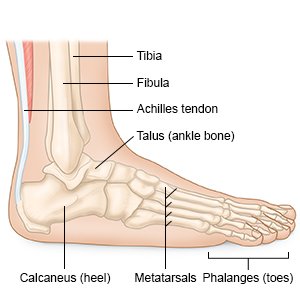Achilles Tendon Lengthening
Medically reviewed by Drugs.com. Last updated on Apr 6, 2025.
What do I need to know about Achilles tendon lengthening?
Achilles tendon lengthening is surgery to stretch the Achilles tendon so you can point your foot up. The Achilles tendon connects your calf muscle to your heel bone. If the tendon becomes too tight, you will only be able to point your foot down. This means you cannot put your heel down when you walk. You may walk on your toes or put your weight on the front of your foot. Pressure injuries can develop, especially if you have diabetes. Surgery allows your ankle to move freely so you can walk with your foot flat on the floor.
 |
How do I prepare for surgery?
- Your surgeon will tell you how to prepare. He or she may tell you not to eat or drink anything after midnight on the day of surgery. Arrange to have someone drive you home when you are discharged from the hospital.
- Tell your surgeon about all medicines you currently take. He or she will tell you if you need to stop any medicine for surgery, and when to stop. He or she will tell you which medicines to take or not take on the day of surgery.
What will happen during surgery?
Your surgeon may do surgery through one or more small incisions into your skin. This type of surgery allows your body to try to lengthen the tendon as it heals. He or she may instead do open surgery. Open surgery is the most common surgery. Your surgeon will make one large incision for open surgery to see all or some of the tendon. Your surgeon will talk to you about which kind of surgery is right for you.
- General anesthesia may be given to keep you asleep and free from pain during surgery. Regional anesthesia may instead be given to numb the surgery area. Your surgeon will make one or more incisions. He or she will then make cuts in the tendon so it can be stretched. The cuts may be along the tendon, or only at one or both ends.
- Your foot movement will be checked to make sure the foot moves properly. Your surgeon may make a few adjustments if the movement is still limited. Your foot will then be held in the correct position. If you have open surgery, the tendon will be sewn back together after it is stretched.
- The incision or incisions will be closed with stitches or staples. A splint, cast, or walking boot will be used to keep your foot in the correct position while the tendon heals.
What should I expect after surgery?
- You will wear a splint, cast, or walking boot for 6 to 8 weeks to keep your foot from moving.
- You will be given instructions for activities to avoid for 6 to 8 weeks after surgery. The instructions will include when it is okay to put weight on your foot.
- Physical therapy may be started after the splint, cast, or boot is removed. A physical therapist can help you strengthen your ankle and improve mobility and flexibility.
What are the risks of Achilles tendon lengthening?
The entire tendon may be cut instead of small portions. Damage to tissues and other areas near the tendon can keep blood from flowing to the tendon. Healing can take longer if this happens. The tendon length can also become too long. This may cause you to walk with more weight on your heel. Pressure injuries can form on the heel over time. The tendon may still be tight after surgery. The tendon can also tear during or after surgery. You may need surgery to repair the torn tendon.
Care Agreement
You have the right to help plan your care. Learn about your health condition and how it may be treated. Discuss treatment options with your healthcare providers to decide what care you want to receive. You always have the right to refuse treatment. The above information is an educational aid only. It is not intended as medical advice for individual conditions or treatments. Talk to your doctor, nurse or pharmacist before following any medical regimen to see if it is safe and effective for you.© Copyright Merative 2025 Information is for End User's use only and may not be sold, redistributed or otherwise used for commercial purposes.
Further information
Always consult your healthcare provider to ensure the information displayed on this page applies to your personal circumstances.
